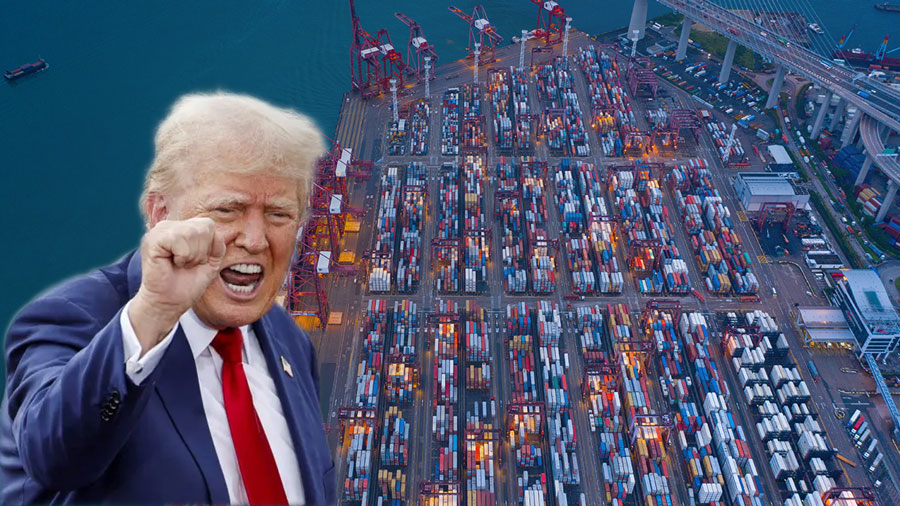


Trump's aides have drafted a proposal to impose a universal 20 percent tariff on nearly all goods imported into the United States.
On April 2, Eastern time, the United States is about to usher in what US President Donald Trump called "Liberation Day" - a number of tariff plans that Trump previously threatened are about to take effect.
Mr Trump has repeatedly threatened that his plans to impose tariffs would make the US "rich". But economists say the tariffs are likely to raise far less revenue than the White House expects.
Trump team too optimistic?
On Sunday, White House trade adviser Peter Navarro said he expected the U.S. government to raise about $600 billion a year in tariff revenue under Trump's New Deal, or $6 trillion over 10 years.
But economists expect the Trump administration's tariffs to generate far less revenue than Navarro claims. Some economists even expect the actual revenue from tariffs to be less than half of what Navarro says.
Mark Zandi, chief economist at Moody's, said revenue of about $600 billion to $700 billion a year was "simply out of the question" and that "you'd be pretty lucky to get to $100 billion to $200 billion."
Is the Trump team just doing sloppy mental arithmetic?
At present, there are big questions about the details and scope of the tariffs, including the amount, duration, products and countries affected, etc. - all of which have a significant impact on total revenue.
According to media reports, the White House is considering imposing a 20 percent tariff on most imports - an idea previously floated by Trump during his campaign. However, the Trump administration could also end up opting for a different policy, such as imposing tariffs on each country based on its own trade and non-trade barriers.
But economists say that based on Navarro's $600 billion revenue projection, he appears to be calculating at a 20 percent tariff rate - the United States imports about $3.3 trillion in goods in 2024, and a 20 percent tariff on all those imports would generate about $660 billion in annual revenue.
Ernie Tedeschi, director of economics at the Yale Budget Lab and former chief economist of the White House Council of Economic Advisers in the Biden administration, said:
"Peter Navarro almost certainly arrived at this conclusion simply by doing some mental math -- and he skipped some key steps in his mental math."
Economists say the many economic effects of tariffs in the United States and around the world must be taken into account if accurate revenue from tariffs is to be calculated - and those effects, taken together, would significantly reduce U.S. government revenue.
What factors will reduce tariff revenue?
First, tariffs typically raise the price of consumer goods - a broad 20 per cent tariff would add $3,400 to $4,200 a year to the cost of the average US consumer, according to the Yale Budget Lab. If the price of imported goods rises, consumers will naturally buy less, and falling demand means fewer imports and less tariff revenue from those imports.
Robert McClelland, a senior fellow at the Urban-Brookings Tax Policy Center, said the tariffs are also expected to trigger "reduced economic activity."
Second, for those US companies that do not pass the cost of tariffs on to consumers through price increases, they will need to bear the burden of tariffs themselves, so profits may suffer and their income taxes will fall.
In addition, if consumers pull back on spending, it will further dent corporate profits and tax revenues. Further, companies whose revenues have taken a hit are likely to lay off workers, further affecting the economy.
Third, other countries are expected to retaliate by imposing tariffs on American products, which will hurt American companies that export their products overseas. At the same time, other countries may experience economic recessions as a result of tariffs, which will also further reduce demand for American products.
"If you raise the tariff rate to 20 per cent, you will have a sharp recession that will destroy your fiscal position," Mr Zandi said.
Economists say there could also be some level of non-compliance with tariffs and U.S. exemptions for certain countries, industries or products.
Finally, economists say the Trump administration may also need to use some of the tariff revenue to pay those hurt by the trade war - meaning that the money earned on tariffs is also wasted.
Trump, for example, did so in his first term: the administration paid $61 billion in "relief" payments to American farmers facing retaliatory tariffs, which, according to the Council on Foreign Relations, represents almost all (92 percent) of U.S. tariff revenue from Chinese goods between 2018 and 2020.





